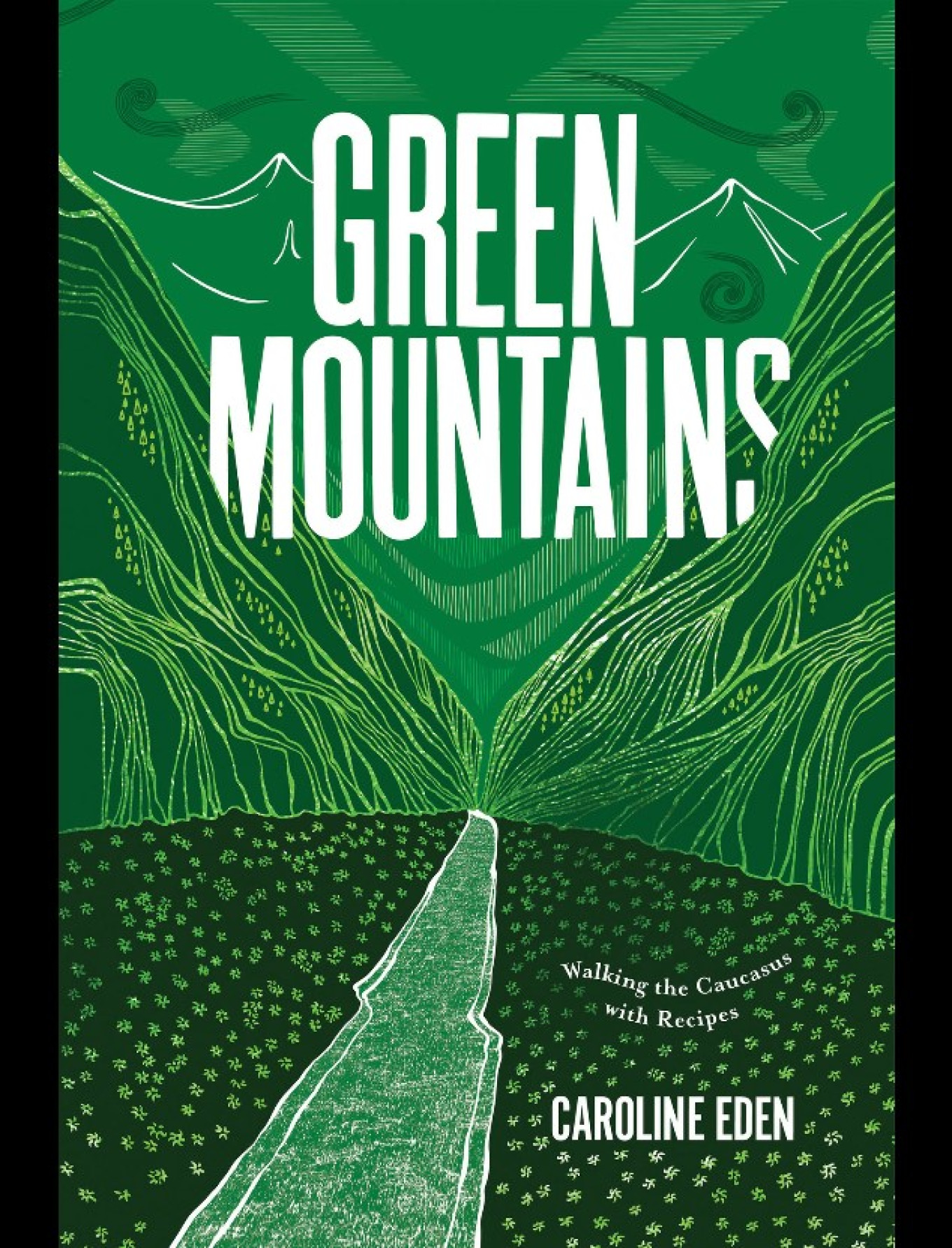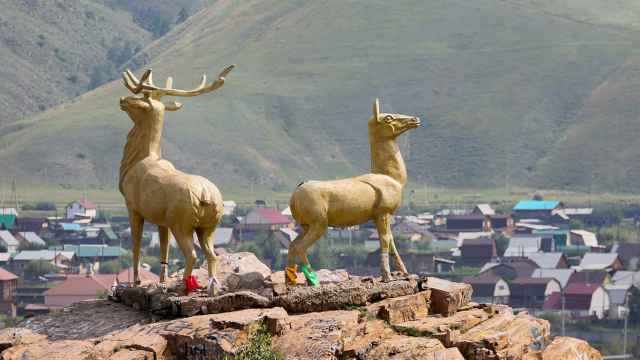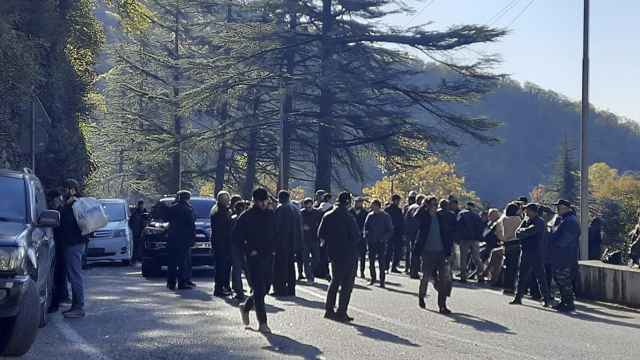Pushkin House: Can you tell us about your ‘color trilogy’?
Caroline Eden: ‘Green Mountains,’ my new book, is the final book in my ‘color trilogy,’ following on from ‘Black Sea: Dispatches and Recipes — Through Darkness and Light’ and ‘Red Sands: Reportage and Recipes Through Central Asia.’
In ‘Green Mountains’ the book travels to the lands between the Black Sea and the Caspian Sea — both of which are central to the first two books — and as well as walking and collecting stories and recipes, I reflect on ten years of researching and writing these books, set most recently against the dark backdrop of Russia's full-scale invasion of Ukraine.
The books all feature a really diverse range of characters whose tales I was proud to recount in interviews and essays: from the last fisherwoman in Bulgaria, to the descendants of Turkish bakers who sailed across the Black Sea to learn the craft of cake-making in Russia in the 19th century, to the harvesters in the world’s largest walnut forests in Kyrgyzstan and a man who cooked plov at the base camp of Peak Lenin for all the top Soviet-era climbers. They are the stars of the books...
All in all, over 10,000 miles travelled on at least 10 forms of transport, I think!
PH: Why are walking and food the two prisms through which you have chosen to explore the countries that you visited?
CE: Two simple reasons: that no feast can beat a post-walk meal and that the green mountains of the Caucasus are capable of transforming just about anyone into a pilgrim.
Slowing down and doing what I could on foot meant time to really think and to see the landscape. As an outsider, by walking, you immediately become part of the scenery. By not shutting yourself away from the world, in the body of a car or bus, you make yourself vulnerable, approachable and more open to encounters. You have to face whatever you walk into, good and bad. Therefore, walking offers the best chance to relish the smells, sights and tastes, all of the sensory things that make up the fabric of a place. By hopefully stepping out, and by putting my trust in walking, I had faith that a certain human, animal, botanical, and edible portrait of Armenia and Georgia would form.
PH: Why did you choose Armenia and Georgia as the focus of your final book, ‘Green Mountains’?
CE: There was a lot of fuss in my mind about the countries and the route. I had hoped to end it in Dagestan but it obviously wasn’t possible to travel there after the full-scale invasion of Ukraine.
My chosen route also meant leaving out neighboring Azerbaijan, also a place of emerald-green mountains, fascinating food (a book ought to be written on the wildly varied pilafs alone), convivial villages and compelling stories. I decided on this because during the course of writing the book, much to the horror of Armenia, Azerbaijan’s lightning offensive triggered the rapid, and traumatic, exodus of almost all ethnic Armenians from Nagorno-Karabakh, ending their centuries-long existence there. Including both countries in one book, for now at least, felt misguided.
PH: Can you talk us through your route in ‘Green Mountains’? How do you decide where to go, the people and places to visit along the way, and was there an element of spontaneity? Did you read anything particularly interesting or useful to prepare for the journey?
CE: Beginning in Armenia, moving northwards through Georgia and ending where the trilogy began, at the Black Sea, the plan was to weave together the enchanting geography and the cult of the kitchen that prevails within these two countries. There was definitely some spontaneity — weather decided on routes quite a lot as I walked both in summer and deep winter. I read a fair amount to prepare, but one of the less likely sources was discovering the work of linguist Marjory Scott Wardrop, who is best remembered for making the first translation into English of the Georgian epic poem ‘The Man in the Panther’s Skin.’ She was a great explorer and linguist. Also books by Joyce Dunsheath, a quietly intrepid English woman who secured a hard-to-get permit to climb the greatest mountains of the Caucasus during the closed-off Soviet era. She wrote about her adventures too in ‘Guest of the Soviets’ (1959) and in the ‘Ladies’ Alpine Club Journal.’
PH: There has been a tendency of ‘othering’ or fetishizing the Caucasus both in Western and Russian literature and travel writing: how do you deal with this in ‘Green Mountains’?
CE: Partly by not dwelling too much on books by English mountaineers and Russian writers, such as Lermontov and Tolstoy, but instead bringing in Georgian mountaineers such as Mikhail Khergiani, ‘the tiger of the cliffs,’ and Guram Tikanadze, who are shamefully not celebrated much outside of the South Caucasus. And writing about artists and filmmakers from the region, such as Sergei Parajanov and Niko Pirosmani but also the sisters Mariam and Yeranuhi Aslamazyan, two incredible Armenian artists that very few people seem to know outside of Armenia.
PH: Along the way you meet many people and take in everything from art, history and literature to nature and (of course) food. Is there a meal which is particularly memorable to you? Which other moments or places during the journey were the most memorable to you?
CE: I have to confess that one of the best meals I ate was in Batumi in Georgia, and that was a plate of croquettes, ordered on a whim and eaten in a small restaurant. They were an unexpected smash hit, filled with beans and served on a sharp tomato sauce. As far as places, I was really enraptured by the wooden mosques of Adjara which are often tucked away in tiny villages, it was a great and enjoyable challenge to locate the mosque, then the key holder…
PH: The food and drink you enjoy is rooted in the landscape. How have the ‘green mountains’ influenced Georgian and Armenian cuisine? And what are the other influences on local cuisine?
CE: One unexpected thing for me was just how much ethnic Armenians from Lebanon and Syria who are fleeing financial collapse and war have opened many restaurants in Yerevan and have shaken up the food scene there. Traditional Jigalov Hats are also important and tell a story: They are stuffed bread (‘hats’ means bread in Armenian) in the shape of a deflated rugby ball, often served with three bowls containing salt, cumin and paprika. Ingredients for the green filling vary, depending on what herbs are available, but typically this will include dill, coriander, greens (maybe spinach or sorrel) and spring onions. These are breads very closely associated with Nagorno-Karabakh, which for reasons I explained above, matters.
PH: What can we learn from Georgian and Armenian approaches/attitudes to food and food culture?
CE: To enjoy it and take time. As Shota Rustaveli, author of the Georgian epic poem ‘The Man in the Panther’s Skin,’ sagely wrote in the 12th century: ‘Spending on feasting and wine is better than hoarding our substance.’ That is the Georgian attitude!
PH: Do you have a favorite dish from each country?
CE: Freshly baked lavash bread from Armenia, the backbone to all mealtimes — incomparable. I also love gata, a cake which is not too sweet and not too salty, and also eetch, bulgur wheat salad infused with tomato juice. In Georgia, for me it’s all about the wine, the liberal use of herbs, the khinkali (obviously) and Svan salt (which typically combines salt, coriander, blue fenugreek, dried marigold petals, garlic, red pepper and caraway seeds) which I think improves almost all soups and stews, and Kakhetian sunflower oil, which is really good.
PH: Which other food writers or travel writers inspire you?
CE: Food writers I enjoy reading include Margaret Visser, Zuza Zak, Alissa Tomishkina, Olia Hercules, Mark Diacono and Diana Henry. Travel writers — the list is long! But three favorites are: Alexander Frater, Jan Morris and Dervla Murphy.
This interview was originally published by Pushkin House, and has been edited for length.
Green Mountains. Walking the Caucasus With Recipes

From Armenia: Apricots for Jam, and Siberia
Leaving the highway behind, the Lada bumped along an appallingly potholed road that had been repeatedly knocked about by earth tremors and landslides. Nonetheless, it led us up most of the way, past the canyon’s huge cliff walls, peculiarly ribbed in long straight lines, giving the appearance of giant pipe organs shooting up from the ground.
To save the tyres, and our spines, we got out to walk to Gndevank, the Lada having managed most of the 15 or so kilometres.
Light fell in shards through the tree branches, dazzling and dancing onto our hot shoulders as we followed the shaded path up to the church which, renovated in the 1960s following an earthquake, was dedicated to St Stepanos, as a nearby sign explained. Soon, the classical conical cupola came into view and as we approached it, not a sound could be heard other than our own footsteps and the buzzing of insects.
Galoshes and sandals were strewn outside the monk’s cells, protected by an ancient dry-stone wall in which two small khachkars, cross-stones, had been artistically set about a couple of metres up. Beehives, painted baby blue and shaded by vines, lined the track to the church’s open door. Small wooden ladders lay about, discarded in the tall grass, presumably for climbing up the fruit trees. Inside, I picked out a lace scarf from the jumble of head coverings by the door and moved towards the altar where candles had burned down to nubs, crossing over rugs in autumn hues of red and orange. Above, a giant chandelier glittered. The interior of the church had the same familiar feeling found in all places of worship, a sense of frozen time and of stepping into a shared human past: a connected community space of exaltation, dignity and beauty, of sadness and grief, of festivities and everydayness where silence is felt not as an oppressive force but as a welcome to focus the mind and human heart. Churches in Armenia, to be present in, to stand in awe of, are loved unconditionally for they contain so much of the beauty and pain that is felt in the world.
We nosed about, admiring the paintings of evangelists and saints, while the headscarf I had tied under my chin scented my hair with the smell of incense. Then, stooping to exit, we followed ancient carved stones, one showing two ibex butting heads, another a hunter mounted on horseback, around the boundary of the church where a signpost with a picture of a snake on it warned of what could be hiding in the long scrub. Cautiously, we walked back to the car and carried on back down the road but we were soon distracted again. Something through the bug-spattered window moved in the distance.
At the bottom of the valley, a large group of people were engaged in what looked like a giant picnic under some shade-giving trees. As we stopped the car and got out, we realised that they were not resting in the heat of the day but working on a project.
‘Watch out for snakes,’ said James needlessly as we walked down a steep slope towards them, a wobbly line of hills and the church in the far distance.
A classical landscape. The heat, combined with the sharp descent, sent my heartbeat pulsing in my ears again. It soon became clear that the group were not sitting on an orange rug, as had first appeared, but were surrounded by thousands of apricots. They spotted us and waved, calling us to come over. As we got closer, the air became weighed down with a sweet, fruity, sugary scent.
A man who seemed to be in charge, dressed in an Airtex T-shirt and chinos, introduced himself as Garik. Chewing on sunflower seeds, a snack ubiquitous in the Caucasus, he pointed up the valley and began to tell us, in Russian (still spoken widely in Armenia), what they were up to.
‘We have a team of fifteen up the mountain picking apricots and eight of us here are sorting them. It’ll take us three days in all to fill the lorry over there. Every year we buy the rights to pick from trees here and then what we can collect goes into the truck. The best apricots will go to Russia, the others will be sent to a local factory for jam.’
All around lay the juiciest-looking fruit. The group of workers knew what to look out for as they were, Garik told us, from Ararat province, a part of Armenia famous for its world-class apricots. The truck, a huge Volvo lorry imported from the Netherlands, its front windscreen kept cool by a blue lacy curtain, would travel slowly for five days or so to a food market in Omsk, Siberia. We wanted to know who in the group would drive the truck such a long way. ‘Me!’ Garik chuckled, jangling the ignition key in his hand. Life looked easy here, but of course it wasn’t.
‘Before, I was working on the road maintenance in Siberia. This is my first year doing this,’ he added, taking a bite of an apricot and handing me a bag that weighed at least two kilos, ‘A gift, take it.’ I protested at such generosity of these fruity treasures, the pride of Armenia, but of course to no avail. ‘Take it, take it. Please.’
‘Why Omsk, not Moscow?’ we asked.
‘Nobody was delivering fruit of this quality there. I saw an opportunity. Of course they have other apricots in Omsk, but not like these. These we call Armenian Dawn apricots.’
I bit into one, the fleshy orange pulp firm (not at all cottony, as is sometimes the way with lesser apricots), tasting of apricot of course but also quince and apple and young grass somehow. A delight, a wonder, the fruit eaten close to where it grew. So good that you could never have enough. A feeling, a taste, impossible to recapture. Still, I tried there and then to mentally bank the flavours.
‘We cannot get apricots like this in Britain,’ we lamented to which we were rightly told, ‘Because you don’t have Armenian apricots in your country.’
‘Vodka?’ Garik asked with an uptick in his voice and a thrust of the chin. ‘No, thank you,’ we replied, explaining that we had to drive to Jermuk.
We shook hands and as I turned to wave goodbye I saw Garik was watching us as we walked away. Having put the apricots in the boot of the Lada, we drove on following the Arpa River into ever higher hills all the while the air becoming cooler, the scenery greener and lusher.
Excerpted from “Green Mountains. Walking the Caucasus With Recipes,” written by Caroline Eden and published by Quadrille Books. Copyright © Caroline Eden 2025. Used by permission. All rights reserved. For more information about Caroline Eden and her book, see the publisher’s site here. You can also purchase this and other books by the author in person or by post in the Pushkin House shop.
A Message from The Moscow Times:
Dear readers,
We are facing unprecedented challenges. Russia's Prosecutor General's Office has designated The Moscow Times as an "undesirable" organization, criminalizing our work and putting our staff at risk of prosecution. This follows our earlier unjust labeling as a "foreign agent."
These actions are direct attempts to silence independent journalism in Russia. The authorities claim our work "discredits the decisions of the Russian leadership." We see things differently: we strive to provide accurate, unbiased reporting on Russia.
We, the journalists of The Moscow Times, refuse to be silenced. But to continue our work, we need your help.
Your support, no matter how small, makes a world of difference. If you can, please support us monthly starting from just $2. It's quick to set up, and every contribution makes a significant impact.
By supporting The Moscow Times, you're defending open, independent journalism in the face of repression. Thank you for standing with us.
Remind me later.






